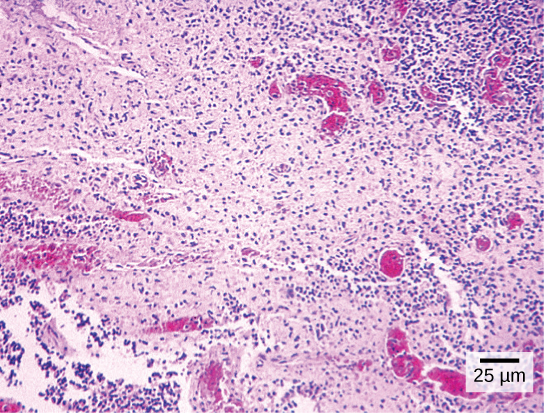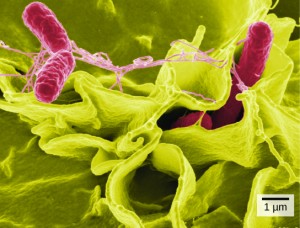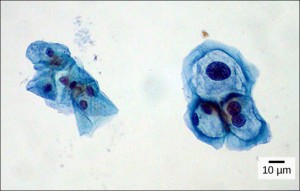Looking at a Cell Under a Microscope
Chapter 3: Introduction to Cell Structure and Office
3.i How Cells Are Studied
By the end of this section, you will exist able to:
- Describe the roles of cells in organisms
- Compare and contrast low-cal microscopy and electron microscopy
- Summarize the cell theory
Watch a video about eukaryotic cells
Lookout man a video most diffusion
A cell is the smallest unit of a living matter. A living thing, like you, is called an organism. Thus, cells are the basic edifice blocks of all organisms.
In multicellular organisms, several cells of i particular kind interconnect with each other and perform shared functions to form tissues (for case, musculus tissue, connective tissue, and nervous tissue), several tissues combine to form an organ (for example, stomach, heart, or brain), and several organs make up an organ system (such as the digestive system, circulatory arrangement, or nervous arrangement). Several systems performance together form an organism (such as an elephant, for instance).
At that place are many types of cells, and all are grouped into one of two broad categories: prokaryotic and eukaryotic. Animal cells, institute cells, fungal cells, and protist cells are classified as eukaryotic, whereas bacteria and archaea cells are classified as prokaryotic. Earlier discussing the criteria for determining whether a cell is prokaryotic or eukaryotic, allow united states of america outset examine how biologists study cells.
Microscopy
Cells vary in size. With few exceptions, individual cells are too small to be seen with the naked eye, so scientists use microscopes to study them. A microscope is an instrument that magnifies an object. Most images of cells are taken with a microscope and are called micrographs.
Light Microscopes
To give you a sense of the size of a jail cell, a typical man scarlet blood jail cell is almost eight millionths of a meter or eight micrometers (abbreviated as µm) in bore; the head of a pivot is near two thousandths of a meter (millimeters, or mm) in diameter. That ways that approximately 250 cherry-red blood cells could fit on the caput of a pivot.
The optics of the lenses of a light microscope changes the orientation of the image. A specimen that is right-side up and facing correct on the microscope slide volition appear upside-down and facing left when viewed through a microscope, and vice versa. Similarly, if the slide is moved left while looking through the microscope, it will appear to motility right, and if moved down, it volition seem to move up. This occurs because microscopes utilize two sets of lenses to magnify the image. Due to the manner in which calorie-free travels through the lenses, this system of lenses produces an inverted image (binoculars and a dissecting microscope piece of work in a similar manner, simply include an additional magnification organisation that makes the final image appear to be upright).
Most student microscopes are classified as light microscopes (Effigy iii.2a). Visible light both passes through and is bent past the lens organisation to enable the user to meet the specimen. Light microscopes are advantageous for viewing living organisms, just since individual cells are more often than not transparent, their components are not distinguishable unless they are colored with special stains. Staining, however, usually kills the cells.
Calorie-free microscopes usually used in the undergraduate higher laboratory magnify up to approximately 400 times. Two parameters that are of import in microscopy are magnification and resolving ability. Magnification is the caste of enlargement of an object. Resolving ability is the ability of a microscope to let the eye to distinguish two adjacent structures as split; the higher the resolution, the closer those two objects tin can exist, and the better the clarity and detail of the epitome. When oil immersion lenses are used, magnification is usually increased to one,000 times for the study of smaller cells, like most prokaryotic cells. Considering light inbound a specimen from beneath is focused onto the heart of an observer, the specimen tin can be viewed using light microscopy. For this reason, for light to pass through a specimen, the sample must be thin or translucent.
Concept in Activeness
For another perspective on cell size, endeavor the HowBig interactive.
A second type of microscope used in laboratories is the dissecting microscope (Effigy three.2b). These microscopes have a lower magnification (20 to lxxx times the object size) than calorie-free microscopes and can provide a three-dimensional view of the specimen. Thick objects tin can be examined with many components in focus at the same fourth dimension. These microscopes are designed to give a magnified and clear view of tissue structure besides every bit the beefcake of the whole organism. Similar light microscopes, most modern dissecting microscopes are also binocular, meaning that they take two divide lens systems, one for each heart. The lens systems are separated by a certain distance, and therefore provide a sense of depth in the view of their subject to brand manipulations by hand easier. Dissecting microscopes also take optics that right the prototype and so that it appears equally if existence seen by the naked center and not as an inverted prototype. The low-cal illuminating a sample under a dissecting microscope typically comes from higher up the sample, but may likewise be directed from below.

Electron Microscopes
In contrast to light microscopes, electron microscopes use a beam of electrons instead of a axle of calorie-free. Not only does this allow for higher magnification and, thus, more particular (Figure iii.four), it too provides higher resolving power. Preparation of a specimen for viewing nether an electron microscope will kill information technology; therefore, live cells cannot be viewed using this type of microscopy. In add-on, the electron axle moves best in a vacuum, making it impossible to view living materials.
In a scanning electron microscope, a beam of electrons moves back and forth across a cell'due south surface, rendering the details of cell surface characteristics by reflection. Cells and other structures are usually coated with a metal similar aureate. In a transmission electron microscope, the electron beam is transmitted through the prison cell and provides details of a cell's internal structures. As you lot might imagine, electron microscopes are significantly more bulky and expensive than are light microscopes.


Cytotechnologist: Take you ever heard of a medical test called a Pap smear? In this test, a physician takes a small sample of cells from the uterine neck of a patient and sends information technology to a medical lab where a cytotechnologist stains the cells and examines them for any changes that could indicate cervical cancer or a microbial infection.
Cytotechnologists (cyto– = cell) are professionals who study cells through microscopic examinations and other laboratory tests. They are trained to determine which cellular changes are inside normal limits or are aberrant. Their focus is not limited to cervical cells; they study cellular specimens that come from all organs. When they detect abnormalities, they consult a pathologist, who is a medical medico who tin can make a clinical diagnosis.
Cytotechnologists play vital roles in saving people'due south lives. When abnormalities are discovered early, a patient's treatment can begin sooner, which usually increases the chances of successful treatment.

Prison cell Theory
The microscopes we use today are far more complex than those used in the 1600s by Antony van Leeuwenhoek, a Dutch shopkeeper who had great skill in crafting lenses. Despite the limitations of his now-ancient lenses, van Leeuwenhoek observed the movements of protists (a type of single-celled organism) and sperm, which he collectively termed "animalcules."
In a 1665 publication called Micrographia, experimental scientist Robert Hooke coined the term "cell" (from the Latin cella, meaning "small room") for the box-similar structures he observed when viewing cork tissue through a lens. In the 1670s, van Leeuwenhoek discovered bacteria and protozoa. Later advances in lenses and microscope structure enabled other scientists to see dissimilar components inside cells.
By the late 1830s, botanist Matthias Schleiden and zoologist Theodor Schwann were studying tissues and proposed the unified cell theory, which states that all living things are composed of one or more cells, that the jail cell is the basic unit of life, and that all new cells arise from existing cells. These principles still stand today.
Department Summary
A cell is the smallest unit of life. Well-nigh cells are and so small that they cannot be viewed with the naked heart. Therefore, scientists must use microscopes to written report cells. Electron microscopes provide higher magnification, higher resolution, and more than detail than lite microscopes. The unified cell theory states that all organisms are equanimous of ane or more cells, the prison cell is the bones unit of life, and new cells arise from existing cells.
microscope: the instrument that magnifies an object
unified cell theory: the biological concept that states that all organisms are composed of one or more than cells, the cell is the basic unit of life, and new cells arise from existing cells
Media Attributions
- Effigy 3.3 by modification of work by CDC, Armed forces Institute of Pathology, Charles N. Farmer © Public Domain
- Effigy 3.4 modification of work by Rocky Mountain Laboratories, NIAID, NIH; scale-bar information from Matt Russell
- Figure three.5 modification of work past Ed Uthman; scale-bar data from Matt Russell © CC By-SA (Attribution ShareAlike)
Looking at a Cell Under a Microscope
Source: https://opentextbc.ca/biology/chapter/3-1-how-cells-are-studied/
0 Response to "Looking at a Cell Under a Microscope"
Post a Comment